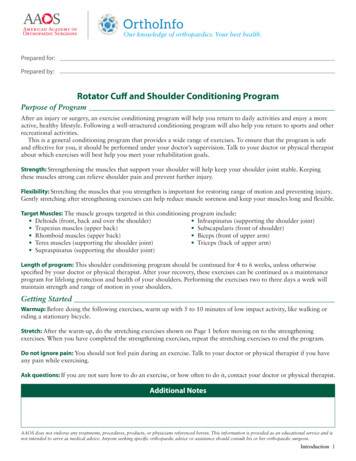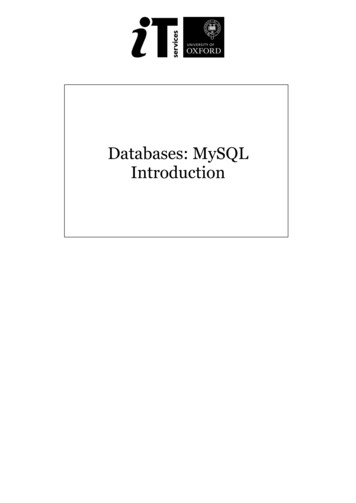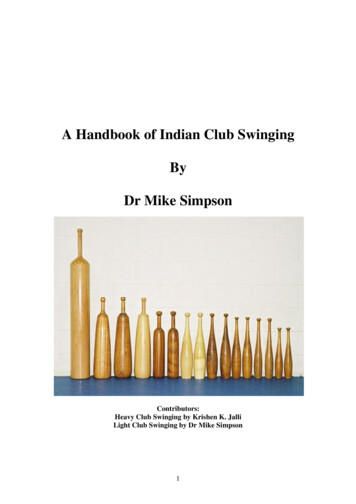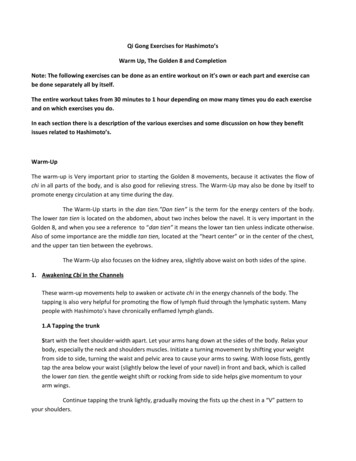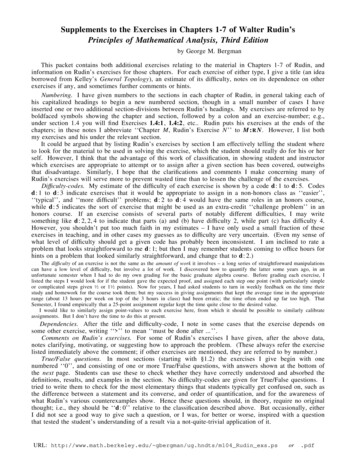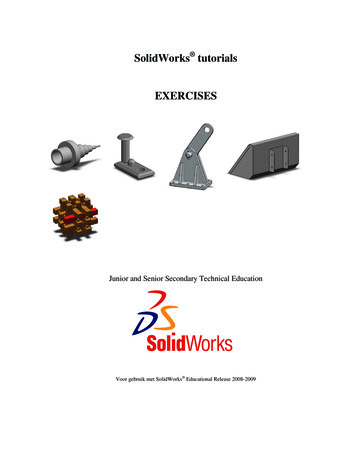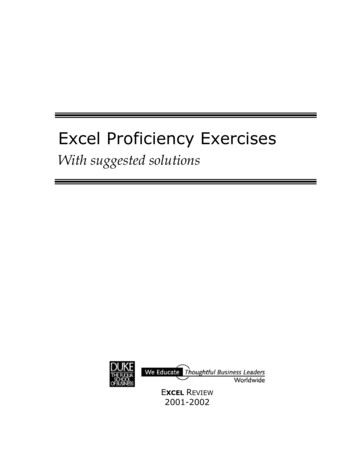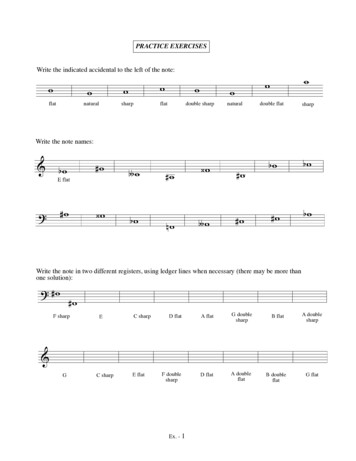
Transcription
PRACTICE EXERCISESWrite the indicated accidental to the left of the note:flatnaturalsharpflatdouble sharpnaturaldouble flatsharpWrite the note names:Write the note in two different registers, using ledger lines when necessary (there may be more thanone solution):F sharpGEC sharpC sharpE flatD flatA flatG doublesharpF doublesharpD flatA doubleflatEx. - 1B flatB doubleflatA doublesharpG flat
COUNTING HALF STEPSWrite the number of half steps between the two written notes. Use a keyboard or a keyboarddiagram for help:Example:Ex. - 2
EXERCISES: ENHARMONIC EQUIVALENCYOn the staff, write an enharmonic spelling for the note provided. There will usually be two answers.Feel free to use ledger DbA B#FbD#GbBbC#Ex. - 3
NOTE VALUE PRACTICEFill in the blanks:Examples: h 4 eighth notes or4 e 1 half noteq 1 whole notee e sixteenth notesh eighth notese 2 sixteenth notesw eighth notesh 2 whole notesq e sixteenth notesx 2 quarter notesw h quarter notesq 4 eighth notesw w half notesx 2 quarter notesEx. - 4
STEM AND BEAMING PRACTICEAdd quarter note stems to the notes below following the rules about direction and length:œœ œ œ œ œœœ œ œœ œœ œœ œ œ œ œ œœ œ œ œAdd eighth and sixteenth stems:œ œ œœ œœ œ œ œ œ œ œ œ œ œ œœ œ œ œ œ œ œ œNow copy the notes from the staff above, or make up your own notes, and group them by twos, threes,or fours. Then beam them according to all the beaming rules:Ex. - 518
RHYTHM EXERCISES 1Practice with counting and Tas.Remember to maintain a steady pulse.144 œ œ œ œ œ 23œ œ œ œ œ œœ œ œ œ œ œ œ œ œ œœœœœœœ œ œœœ œ œ œ œœ œ œœ œ 42 œœ œ œ œ43 œœ œ œ œœœœ œ œœœ œœ œ œ œ œœœœœœœœœ œ œœœEx. - 6œœœœ œ œœœ œ œ œœœœ
RHYTHM EXERCISES 2Practice with counting and Tas.Remember to maintain a steady pulse.1244 œ Œ œ ŒœœŒ œœœœ œ Œ œ œ Œœ œ Œ œœœœœ43 œœœ3œœ œ œ42 œœŒŒŒœŒ œ Œ œœ œ œ œ Œœ œ Œ œ œ œœ œ œ ‰Jœ œ œ œEx. - 7œ œ œwœœœÓœ œ œÓœ œ œœ Œ!œJ‰Œ
NOTE VALUE PRACTICE II4q.e 3 half notesorh.3 quarter notes or e. 1 dotted quarter noteÓe. 3 quarter notesŒ. 9 eighth restsw.q!q.w. 6 half notes 1 dotted half note 2 dotted eighth restsh . 6 quarter notesq.q. q e sixteenth notes eighth rests eighth notes half notesŒ . 6 sixteenth restse. 6 sixteenth notese 1 dotted half note‰ . 3 sixteenth rests a dotted whole noteAssuming the quarter note gets the beat, write the number of beats for each example:h.w.q . q .q . eqhwwEx. - 8hhqh
RHYTHM EXERCISE 3(You may want to write in the "down" and "up" beats as I've done in the first example)4 œ œ œ.41œ œ œ œ œ œ œ Œ œ œ œ œ œ œ J1 & 2 & 3 & 4 &(etc.)(I've underlined the "attack")43 2 œœœ œ œ42 3 œœœ œŒœœœœ œ œœœœEx. - 9œ œ œ œ œ .œœ
CUMULATIVE EXERCISESFind all the errorsj3.&4 Œ œ œ ‰ ‰ œjœj 4? Œ‰œ4Óœœ Ó.œœœœœœœœœbœ œ œ œj .œ œr œÓ Add the proper note or rest value as requested to complete the measure& 43 œEbœ.RestEx. - 10Rest(s)œ !JA (you'll need a tie)
Ex. - 11
ECONOMICAL DEVICES EXERCISESIn the empty staves provided, write out each example as it would appear withoutthe repeat symbol/device.4 œ œ œœœœ414434444 œ œ 33. œ œ œ œ œ344 œ œ œ œ œ œ2œœœœ œ 3œœœœ œ œ œ œ œ œ . 2.œ œ œ œ œ œ œ œ1.3œœœ œ œ œ œ œ œ œ œ .3œ œ œ œFineœ œ œœœ œœœœ D.C. al Fine44Ex. - 1243
ECONOMICAL DEVICES EXERCISES CONT'D42 œ œ4%œœœ œœœœ Fineœœœœ œ œœœœœD.S. al Fine4243 .5fi Codaœ œ œ œ œœœœfiœœ œ œ .D.C. al Coda .43Ex. - 1344
SCALE EXERCISESWrite ascending, then descending major scales starting from the given notes.Remember to follow the WWHWWWH pattern and to use accidentals where appropriate.&A MAJOR?E b MAJOR&E MAJOR?F MAJOREx. - 14
KEY SIGNATURE EXERCISES1.Name the key:2. Using key signatures, write the following ascending major scales:&A MAJOR?D MAJOR&B b MAJOR?E b MAJOREx. - 15
TRANSPOSITION EXERCISESThis melody is in the key of F Major. Transpose it into the following keys using the appropriate key signature.(Can you name the tune?)4&b 4 œœœœœœœ œœœ œœœ œœœœœœœœ œœœœ F MAJOR? 44B b MAJOR& 44G MAJOR54Ex. - 16
MINOR SCALE EXERCISESUsing a key signature, write the specific type of minor scale below Remember that a minor scale keysignature comes from its relative major key signature.&C NATURAL MINOR&C HARMONIC MINOR&C MELODIC MINOR (ascending and descending)&F HARMONIC MINOR&F NATURAL MINOR&F MELODIC MINOR (ascending and descending)Ex. - 17
SUMMARY ASSIGNMENT FOR:SCALES, KEY SIGNATURES AND THE CIRCLE OF FIFTHSOn staff paper:Pick two major keys: One that uses flats and whose tonic is a flat note, such as: Bb, Db, Eb, Gb, Ab One that uses sharps, such as: G, A, B, C#, D, E, F#Write: The key signature for each key, in treble and bass clefs The key names and their key signatures for the keys that are one key away in the circle offifths and fourths (i.e. clockwise and counter clockwise) in treble and bass clefsWrite out the scales without key signatures (i.e. putting in each accidental where appropriate) intreble and bass clefs: For each original key, write out that major scale Write out the relative minors for each of the two original major keys Write out the harmonic and melodic forms of the two relative minor keysFor all the above scales, write the notes as whole notes, but do not worry about time signatures orbar lines (as represented in earlier pages).Label everything very clearly and space things out as much as you need to on the page(s). Copythe format used in the examples on the preceding pages. Imagine that someone else (aperformer) could be reading this and that you might not be on hand to answer any questionsabout which notes you want “played.” For example, you would not want a performer to look atyou score and not be able to determine if a note is a G or an A because it is not perfectly centeredon that particular line or space, or because the note head is too big and it overlaps on a line and aspace.Ex. - 18
INTERVAL EXERCISESName the interval:w&wb b wwww& wwb wwww? b www#wb wwWrite the interval above the indicated note:?wP4bwm3wm7&&#wbwm7m6wwA5wP8P5wbww#wb wwwwwwwbwwM6? b wwb www#wwwb wwEx. - 19A4wd5wM2Invert these intervals (either direction) and name the inversion:& wwM7wWrite the interval below the indicated note:wwwm6m2w#wb wwwwww
FINDING INTERVALS IN A PIECE EXERCISESMINUETJ.S.BachBWV Anh. 115IN G MINORœb 3&b 4œœœm3Sample Answer? b b 43 .&b5b œœ œ œ œ œ? b b 9&bb œ? bb .b œ&b13 .? bb n œœ .œ œ œ œ .œœ.œ œ œ œ .œ œ œ œ œœœœ #œœœ .œ œ œ œ .œ œ œ œ œœœœœ . œœœœœœœbœœœEx. - 20œœœ œ œ œœ œ nœ œœœ œ œ œœ œ œ œ . .œ. .
& w& wMMwwAug.#w# wMAug.MwwMMbw ? wb wdim.? Mwdim.Mbwb wmbwb wmwwAug.#w# wMmmAug.b wwwwwwbAug.# www# wwwAug.MEXERCISESIwww TRIAD#wbw? ww#wwbwbwbwww& wwwwwb wwb#Aug.wwwbdim.www ? wwwM b b wwwmwwwM# wwwMbwbM&wb w areIndicate whether the following triads# www# wwwwwwwwwb wwwb wwwwwwwwwmajor (M),(m), augmented(Aug.),ordim.diminishedM minorAug.MMM (dim.):m&&wwwwwwb wwwb wwwwwwwwwmmwwwwb www& wwwwwMwwwmb wwwm as indicated.&Complete the triadM? bw44? Mwm#wM? b wwwb www # # # www54Write? theMfollowingm triads: M&D Aug.& # # wwwD Aug.A dim.b wwwA dim.F #M# # # wwwF #M?# ww ? b wwwwwwwwww# www ? b wwwwwwmdim.Aug.dim.wwwThe bottom note is provided:dim.wdim.b wwwdim.Gmb wwwGmAug.dim.w&Aug.wdim.# # www & wwwAug.B bMb wwwdim.mb wwwb wwwmm# # www# # www# # www# # wwwMMbwwMmb b wwwb wwwMmG Aug.Cmwwwwww?B bM?84Ex. - 21wwwFM# wwwG Aug.b wwwCmMwwwwwwwwwwwwMwwwwwwmmMw#w# www# # # wwwAug.Aug.?FMMB dim.wwwB dim.MMA bMbwb wwA bM
&D Aug.&w& #D#Aug.& wwF #MA dim.b wwwA dim.GmB bM?FMG Aug.CmB dim.TRIADS EXERCISESII?wwww# #F##Mwww Gmb www Bb bwwM ? FMwww G #Aug.wwwbCmB dim.BelowDaAug.triad is Aprovided.dim.F #MGmB bMFMG Aug.Aug.A dim.F #MGmB bMFMG Aug.Write DthecorrespondingRomannumeralaccordingw to the given key:b bAwwwbMA bMA bMwwwb wwwb www# wwwwwwbwwwww b b wwwwww#www#FMG Aug.BwwwbCm# wwwwwdim. b bAwwwbMwwwCMFmFMCmGMDMAMAmB bM(harmonic#bD Aug.A dim.FMGmBMwwwFM GwwAug. # wCm Bwwdim. b bAwwwbMversion)wbwww?wwb wwb wwn wwwwww#w& wwwww b b bb wwwwwwbwww?#wwwwbwbwbwnwwCMFmEMFMCmGMDMAMAmBM ww# ww Roman# wwnumeralwwprovided:www according& www the triadw given notew ? to wwthe key andb wwabove btheCompletebwnw(harmonic#w&CM wIV Fm iiwo EbM wiii FM iii CmwV GM vi DM vii o AM wii Am iv BbMb wIVversion)CMFmE bMFMCmDMAMAmB bM(harmonicGMwb nwww#wb w version)& wwwwwobbM V b Dm VIICMVGMiiFMiiiBMIVAmIIIAMVCMviiFmiv AmEivooCM IVFm iiE bM iii FM iiiCm VGM wviDM viiAM iiB Mb IVwwwwwww& wwbwww?#wwwwwbbwbwnwww(harmonicw version)#w& wwwwwoCM IV (writeFm iitheE bM iii triadsFM iiifor) theCmwVviw scale.DM vii oAM iiAm ivB bM IVHarmonizediatonicB flatGMmajorwww#wwwww?wwwwa key signature:w(harmonicbwwbwwUseonewmeasurewper triad wand DO NOTuseww&wwwbwbwversion)bw&oCM VGM iiFM iiiB bM IVAm IIIAM VCM viiFm ivwE bM V b wDm VIIwwbwbwwww& wwwwwwwwb wwbw& bwb:B152IiiiiiIVVvivii o?b wwwwwwwbwbww& wwwwwwwbwbwHarmonize?b b w the D minorwscale.obwwUseper triaduse a keysignature. wB :one measureIii and DO NOTiiiIVVviviiwbwbwwww the Harmonicwww& thatwwww the 5th chordAssumeb www comes fromb ww minor mode:b155oB b:iiiiiIVVvivii? Iwwwb wwwb wwwwww? www# wwwb www?& # # www& D#wwwAug.& # www?d:161?d:d:?167b wwwwwbAbbdim.wwwwwA bM# # # wwwb#Fwwww#M# # wwE bMb wwwwwwwwwbGmb wwwb www-2wb wwiv# www-2-ivVwwwwwwib wwwii owwwwwwIIIiiiIIIiiiooIIIb ww ?nBwwwwwbM?bwiv-2Ex. - 22?173V# wwwVCmCmB dim.B dim.VIwb wwVIwb wwVIwwwVIIwwwVIIVII
7TH CHORDS EXERCISES7TH CHORDS EXERCISESGiven the root, complete the indicated 7th chord:& wmin. 7wdom. 7wbwwwww# wwwwhalf dim. 7?maj. 7wdim. 7Analyze the following 7th chords in terms of the provided key:? wwwwAm:CM:wwwwCM:&Gm:wwwbbwE bM:wwdom. 7b wwwwCm:min 7b wwwwFM:wmaj. 7# wwwwDM:Given the key and root, complete the 7th chord and provide its roman numeral:&CM:wFMw#wAm:Dm:w?Ex. - 23bwB bM:Gm:wwwCM:GM:
CHORDINVERSIONEXERCISESCHORDINVERSION EXERCISESw& wwwwwName the inversion (R, 1st, 2nd, 3rd):wwwwwwwwThe root of the triad is given. Fillin the remaining notes accordingto the indicated inversion:& ww2nd1stwwR1stwwwwwwwwwwwwwwwwSame thing, but for 7th chords:2ndww3rd2ndwRwwwwwwww1st2ndIn the key of CM, spell the followingchords with their indicated inversions:&I 1stii RIM7iii 2nd IVM 7 Rvii 1stV 2ndV7Rvi 3rdIV 2nd?Rewrite the following inverted chordson the bottom staff so that they are inroot position:&wwwwwwwwwwwww&Ex. - 24wwwwwwwwwwww
& wwwCM V& wwwCM V& # wwwwV7& # wwwwCM VwwwGMww iiwGM iiGM iiB M IVAm IIIwww ? AM# wwwV CMwvii Fmwivwwwwwb b wwb b wwwoFMww iii BbbMwIV Amwww III? AM# wwwV CMwwvii Fmb wwivwwbwb wwoFM iiiB bM IVAm IIIAM VCM viiFm iv# ww FIGUREDn ww BASS EXERCISESc# ww# ww# wwwø7nviiwwwo7viic#w#wFM iiibvii ø7viiwwwGiven thewchord, writeww its name,wquality andwwwfigured? bass:w& wwwwwww ? wwwwwwwww& wwwwwww ? wwwwwwwwww54/1 &wwwwww6 ? Bwwo64w66CMGMwEm 3Amwwwww& thewwfigured bass, spell 7V7FM 6iiAmFM 6Amiii 64Dm 3vii o 6B o6 4?I4Am 6ww 43 Bwo6wwww 6DmAmwwww ? wwwb wwwwwww&wwwwww& wwwww67wo66o 6termsIn the keythe giveninof Amiiiii 4chords wviiI 46wwV6of GM, analyzeww4wFMAmDmB3w ? wwtheirbass:w numeral,wwquality andwwwfigured& Roman4o66FM iii6ww -3w6V 4 -3-?#224?#228Ex. - 25?#234wwwI6wwwwwwwwwwwwDmwww34w4Dm 3iii47Em 2wwwwwwwiii347EmwwEm 42www4wEm 2wwwwiii 7E bM VDm VIIE bM VDm VIIb wwwE bM Vb wwwwwwwwwwwwwwwwwwww6GMwwwwAmwwwAmGM4IV 2Gm 6wwwwww4wwIV62GmwGm 6wwwwGmwwwwwwwDmwVIIww66vi 6 6CM 4wwwwwwvi 646CMwwwCM 64wwww& b6CM 4&4IVM 2wwww4IVM 3b
APPLIED FIGURED BASS/INVERSIONS EXERCISESAnalyze the following piano piece in terms of its figured bass:& 42 œœœ œœœF? 42 œAllegroPianoPno.œœœœœœœ& œœ œœ œœ œ6I4Iœœ œœœœœœœœviiFineœœœœ œœ œœ œœ6I4Iœœœœœœœ f.œD.C. al Fine 6I4V7I.6I4Spell the triad according to its key and inversion. Use four notes (two in the bass, two in thetreble) so that one note in the triad will be doubled, and so that the voicing will be wide enoughfor the top note to be more than an octave away from the bass note:4ii 3ii7V6V4Ex. - 264ii 3ii 7VV7
CADENCE, PHRASE, PERIOD EXERCISEWrite a four-phrase period with the order of cadences as follows:1st phrase:2nd phrase:3rd phrase:4th phrase:Plagal cadenceHalf cadenceDeceptive cadenceAuthentic cadenceThese phrases will just be harmonic progressions without any melody, so just write the chordsand the analysis on one staff. Mark the cadences and use chord inversions where appropriate.(You may not need all four staff systems).Ex. - 27
MELODY EXERCISESWrite four melodies of no more than four measures each. Make two in a major key and two in aminor key. Remember to use the leading tone (raised 7th scale degree) in the minor mode if youend going from scale degree 7 to scale degree 1.Ex. - 28
MELODY HARMONIZATION EXERCISEAdd chords to these simple melody lines so that each note is a chord tone. Hint: a “typical”approach to harmonizing will have you start and end on the tonic. Also, think about what kind ofcadence will fit with the last two notes of each line. Write the chords in the bass clef and alsoprovide a Roman numeral analysis.Key of C major:Key of A minor:Ex. - 29
CHORD TONES EXERCISEWrite melodies for these two chord progressions using only chord tones. For the minorprogression, remember that the V chord (and possibly the viio chord) is made with a raised 7th(leading tone). The melody must also reflect that change if the 7th note in the scale/key is usedover those harmonies.&b& b ?bF:I? b & b ?b F: b&VId:i? b &d: b œi I viIviV œivœ iiii iiv iio VIiiioVI V7 wwwwwwIV7# # V7IwwwwiV7iDouble NTSusp.CTPT CTCTCT NT CTœœœœœœœœœœ œ œ& b œ œ œœ œwœ œ ? ww b While using only chord tones in a melody “works” in terms of fulfilling the basic rules of cord-tone Iwriting, it V i
Ex. - 8 NOTE VALUE PRACTICE II _ _ 4. 3 half notesorh. _ 3 quarter notes e 1 dotted quarter note e. 3 quarter notes Î. 9 eighth rests w. 6 half notes q 1 dotted half note 2 dotted eighth rests h. 6 quarter notes q a dotted whole note Î. 6 sixteenth rests e. 6 sixteenth notes e 1 dotted half note ä. 3 sixteenth rests or. qe .


